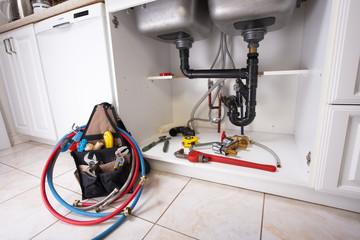Plumbing is your home’s circulatory system, running unseen behind walls and under floorboards, transporting water to and from fixtures. Regular maintenance and occasional repairs keep it functioning properly. Contact Rosenberg Plumbing for professional help.
Various materials make up plumbing systems, chosen for their durability, resistance to corrosion, and cost-effectiveness. Understanding how these factors affect your home’s plumbing is essential for making informed decisions about repair and replacement.
Plumbing is the network of pipes, fixtures, and other devices that deliver clean water and remove waste in residential and commercial structures. Skilled plumbers install, repair, and maintain these systems. Their work helps ensure that people have safe, potable water and that waste is removed in a way that protects the environment and public health. While the work can be demanding, it offers a steady income and career stability.
The history of plumbing stretches back thousands of years, with ancient civilizations developing ingenious methods to transport and manage water. The Romans, for example, built sophisticated aqueducts and public baths that advanced their culture’s approach to sanitation. Today’s plumbing continues to evolve as experts focus on sustainability and efficiency. Plumbing systems are now designed to reduce water consumption and support the use of recycled materials. Smart technology also allows homeowners to monitor and control their plumbing remotely.
While the duties of a plumber vary, all plumbers must have certain traits to succeed in the profession. Strong communication and problem-solving skills are essential, as is the ability to collaborate with colleagues and customers. Many plumbers also need to be physically fit as they often work in tight spaces or on ladders.
Plumbers install a variety of pipes and fixtures, including sinks, toilets, bathtubs, showers, and water heaters. They may also work on gas lines. Installing these systems requires knowledge of building codes and regulations, as well as specialized tools. Plumbers must also be able to read blueprints and understand how different components interact with each other.
Once pipes are installed, they must be tested for leaks and proper functioning. Common problems include dripping faucets, water stains, and smelly or clogged drains. These issues can be caused by a variety of factors, such as worn washers or O-rings, corrosion, loose connections, or extreme temperature changes. Plumbers are trained to identify and fix these problems quickly and efficiently.
Plumbing is an ingenious system that enables people to enjoy the benefits of clean, fresh water without causing harm to the environment or their health. As such, it is vital for every home and business to have a properly working plumbing system.
Plumbing and Piping
Plumbing and piping are two distinct systems found in industrial facilities, though they may be confused due to their similar appearance. Both systems have specific needs and regulations that they must follow in order to function correctly. Plumbing is designed to bring water into a building and safely dispose of waste through drainage systems, while process piping is built to move chemicals, gases, water, and other materials between manufacturing stages of production.
Piping is the term used to describe any system of pipes used to transport fluids. Most of us are familiar with the plumbing piping found in residential homes, which includes the pipes that supply water to household fixtures and remove wastewater through drains and sewer systems. This system also includes the pipes that transport gas through a home’s ventilation and heating systems.
In the context of industrial settings, piping can be made from an array of different materials, depending on the application. For example, a pipe might be made from metal alloys like Inconel, titanium, or chrome-molybdenum in order to meet specific operating conditions. Piping systems are often tested using stress analysis in order to determine how much strain the pipes can handle before they start to fail.
The difference between piping and plumbing is that plumbing is concerned only with the movement of water and other liquids, while piping can transport any type of material. Additionally, a piping system is usually built in accordance with the requirements of a particular industry, while plumbing is constructed according to local building codes and health regulations.
The primary function of a piping engineer is to manage the piping engineering activities and deliverables on an assigned project. This includes reviewing and interfacing with discipline lead engineers to ensure that the design processes are in line with project requirements and objectives. It also involves performing technical evaluations and preparing piping construction scope of work. This includes drafting and preparing pipe specifications, specifications of valves and special items, reviewing piping drawings and data, preparing pipe isometrics mark-ups, and ensuring that all stress recommendations are incorporated into the piping design.
Plumbing Tools
Professional plumbers use a variety of tools to perform repair and installation tasks. Some common plumbing tools include an adjustable wrench, plunger, tubing cutter and pipe cutter, drain auger, and a caulking gun. Investing in high-quality tools ensures durability and efficiency. It is also important to consider your space and budget when selecting plumbing tools. Look for versatile tools that serve multiple purposes to streamline your toolkit and reduce fatigue.
A pipe wrench is one of the most basic and essential tools in a plumbers’ kit, as it can grip a range of diameters of pipes and fittings. It is a must-have for assembling and disassembling metal pipes. Choose a plumbers wrench that is made of sturdy materials to ensure longevity.
Another essential tool is a tubing cutter, which can cut copper and PVC pipes. A good cutter has a long blade and a durable body to withstand wear and tear, and it has an adjustable jaw to accommodate different diameters of tubes. You can also opt for a hacksaw, which is less precise but offers greater versatility.
Lastly, a good drain auger is an efficient tool for removing clogged pipes and drains. Unlike chemical drain cleaners, which can be harmful to your pipes, a sink auger has a flexible cable that extends down the drain, grabs the clog, and pulls it out.
Depending on the type of pipe, you may need other tools such as a threader to create secure connections, a tubing bender for making precise bends, and a flaring tool that creates flared ends on copper pipes. A propane torch is also a must-have for soldering copper pipes, and it should have a reliable ignition system and adjustable flame control. You can find these and other necessary plumbing tools at hardware stores or online platforms such as plumbing tool kit screwfix. Keeping a quality toolkit in your home will enable you to fix minor issues and prevent larger problems. However, if you encounter major leaks or damage to your plumbing system, it is best to call in a professional plumber for a professional assessment and repairs.
Plumbing Safety
Plumbing systems are complex and integral to our everyday lives, but they can also be dangerous when not properly maintained. Plumbing problems such as leaks, clogs, and faulty installations can lead to property damage and safety hazards in the home. These issues can also compromise your water quality and expose you to health risks. By following some basic plumbing safety guidelines, you can protect yourself and your family from these dangers.
One of the most important things you can do to ensure your plumbing safety is to turn off your home’s water supply before beginning any work on the pipes. This will prevent any accidental flooding and minimize the potential for water damage. You should also wear gloves and goggles when working on plumbing projects to protect yourself from cuts and chemicals. You may also need to wear a mask if the project involves working with mold or other hazardous materials.
Another way to protect your plumbing safety is to make sure that you use only approved and recommended plumbing products. These are usually clearly labeled and will have instructions for safe use and disposal. Unapproved plumbing products can be a hazard and may contain harmful chemicals that can irritate your skin or eyes.
It is also essential to be prepared when working on plumbing projects by having the proper tools and supplies. This will help you complete your projects quickly and effectively. You should also be familiar with any applicable codes and regulations for plumbing in your area before starting a job. For example, if you are installing a new fixture, you will need to know whether or not it is compatible with your existing water line. You should also not cut into walls or ceilings blindly without knowing where the pipes, electrical components, and ducts are located. This will ensure your safety and avoid costly repairs in the future.


